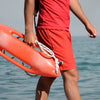Lifeguard Outfits: Exploring the Perfect Lifeguard T-Shirts and Tank Tops
Lifeguard outfit is meticulously designed to balance functionality, professionalism, and comfort while ensuring the safety of individuals in aquatic environments. The question often arises: can lifeguards wear T-shirts or tank tops as part of their uniform? In this blog, we’ll delve into the suitability and considerations regarding the use of T-shirts and tank tops in lifeguarding attire.
Functional Considerations:
1. Comfort and Mobility:
• T-shirts or tank tops can offer comfort and breathability, especially in hot weather conditions. They allow for ease of movement, crucial for lifeguards during rescue operations or extended hours on duty.
2. Sun Protection:
• Long-sleeved T-shirts or those with UV protection can offer additional coverage against harmful UV rays, safeguarding lifeguards from sun exposure during prolonged periods outdoors.
Workplace Dress Codes and Policies:
1. Uniform Guidelines:
• Many lifeguard employers or organizations have specific dress codes mandating the use of designated lifeguard attire. In such cases, T-shirts or tank tops might not be permitted as part of the official uniform.
2. High-Visibility Attire:
• Lifeguards often wear distinctive, high-visibility uniforms for easy recognition. T-shirts or tank tops might not adhere to the visibility standards required for immediate identification by beach or pool visitors.
Professionalism and Readiness:
1. Maintaining a Professional Image:
• Lifeguards project professionalism and authority through their attire. Official lifeguard uniforms often include specific colors and designs, contributing to a unified and professional appearance.
2. Identification and Authority:
• Lifeguards’ attire, including the uniform, serves as a symbol of authority and readiness. T-shirts or tank tops might not align with the expected image of a lifeguard, potentially affecting public perception.
Safety and Functionality:
1. Swift Response to Emergencies:
• Lifeguards need attire that facilitates swift response during water-related emergencies. The specific design and functionality of lifeguard uniforms cater to the demands of rescue operations.
2. Equipment and Accessories:
• Lifeguard uniforms often feature pockets or compartments for essential equipment and accessories. T-shirts or tank tops might lack these functional features necessary for lifeguard duties.
Conclusion:
While T-shirts or tank tops might offer comfort and flexibility, their suitability in lifeguard attire largely depends on workplace dress codes, policies, and the specific requirements of the lifeguarding role. Lifeguards prioritize safety, professionalism, and the ability to respond swiftly to emergencies, factors that are often considered when determining appropriate uniform attire. Adherence to official lifeguard uniforms ensures visibility, professionalism, and readiness, highlighting the lifeguard’s commitment to ensuring water safety and maintaining a professional image in their critical role.
Functional Considerations:
1. Comfort and Mobility:
• T-shirts or tank tops can offer comfort and breathability, especially in hot weather conditions. They allow for ease of movement, crucial for lifeguards during rescue operations or extended hours on duty.
2. Sun Protection:
• Long-sleeved T-shirts or those with UV protection can offer additional coverage against harmful UV rays, safeguarding lifeguards from sun exposure during prolonged periods outdoors.
Workplace Dress Codes and Policies:
1. Uniform Guidelines:
• Many lifeguard employers or organizations have specific dress codes mandating the use of designated lifeguard attire. In such cases, T-shirts or tank tops might not be permitted as part of the official uniform.
2. High-Visibility Attire:
• Lifeguards often wear distinctive, high-visibility uniforms for easy recognition. T-shirts or tank tops might not adhere to the visibility standards required for immediate identification by beach or pool visitors.
Professionalism and Readiness:
1. Maintaining a Professional Image:
• Lifeguards project professionalism and authority through their attire. Official lifeguard uniforms often include specific colors and designs, contributing to a unified and professional appearance.
2. Identification and Authority:
• Lifeguards’ attire, including the uniform, serves as a symbol of authority and readiness. T-shirts or tank tops might not align with the expected image of a lifeguard, potentially affecting public perception.
Safety and Functionality:
1. Swift Response to Emergencies:
• Lifeguards need attire that facilitates swift response during water-related emergencies. The specific design and functionality of lifeguard uniforms cater to the demands of rescue operations.
2. Equipment and Accessories:
• Lifeguard uniforms often feature pockets or compartments for essential equipment and accessories. T-shirts or tank tops might lack these functional features necessary for lifeguard duties.
Conclusion:
While T-shirts or tank tops might offer comfort and flexibility, their suitability in lifeguard attire largely depends on workplace dress codes, policies, and the specific requirements of the lifeguarding role. Lifeguards prioritize safety, professionalism, and the ability to respond swiftly to emergencies, factors that are often considered when determining appropriate uniform attire. Adherence to official lifeguard uniforms ensures visibility, professionalism, and readiness, highlighting the lifeguard’s commitment to ensuring water safety and maintaining a professional image in their critical role.
- Posted in Lifeguard Apparel, Lifeguard Clothing, Lifeguard Outfit, Lifeguard Retail, Lifeguard Shirt, Lifeguard Shop, Lifeguard Store, Lifeguard Tank Top, Lifeguard Tops

